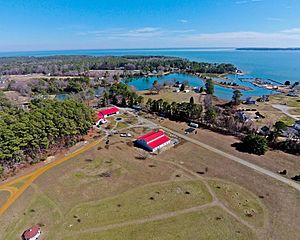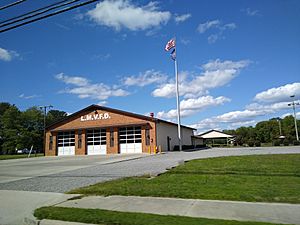Deltaville, Virginia facts for kids
Deltaville is a small community in Virginia, USA. It is located on the eastern tip of Middlesex County. This area is well-known as a great vacation spot. People come here for sailing, fishing, and other water sports. Deltaville was once a big center for building boats. These boats were mostly for commercial watermen who worked on the bay. Today, you'll find many marinas, boatyards, and businesses related to the water. The ZIP code for Deltaville is 23043.
Contents
Deltaville's Past: A Look at Its History
How Deltaville Got Its Name
This community was first called Sandy Bottom. In 1909, the people living here decided to change the name. They thought of "Delta" because of the town's shape. Deltaville is surrounded by water on three sides. The Rappahannock River is to the north, the Piankatank River is to the south, and the Chesapeake Bay is to the east. Since there was already a Delta, Virginia, they added "ville" to the end. That's how Deltaville got its unique name!
Fun and Sports in Deltaville
For over 50 years, Deltaville has been home to a semi-pro baseball team called the Deltas. Their home field is the historic Deltaville Ballpark, built in 1948. Beyond baseball, the town offers many ways to stay active. There's a community pool, tennis courts, a basketball court, and a playground. All these facilities are built and kept up by volunteers from the Deltaville Community Association. They work hard to make sure everyone has fun.
Exploring the Deltaville Maritime Museum
The Deltaville Maritime Museum and Holly Point Nature Park is a special place. It's located at 287 Jackson Creek Road. This park covers 36 acres and has access to both Mill Creek and Jackson Creek. It's home to the F.D. Crockett, a historic boat listed on the National Register. The museum and park opened in 2002. Their main goal is to share the history of Chesapeake Bay watermen. They teach about their boats, fishing, and how they worked. The museum also hosts farmer's markets, plays, concerts, and holiday events all year long.
The Legend of Stingray Point
The very tip of Deltaville is called Stingray Point. This name comes from a famous event on July 17, 1608. Captain John Smith was exploring the bay. He was stung by a stingray there. Captain Smith thought he was dying from the sting. He even told his men to dig a grave for him. But a doctor on his crew, Walter Russell, put a special oil on Smith's wound. Captain Smith got better! He recovered enough to eat the stingray for dinner that same evening.
Deltaville's Resilience: The 2011 Tornado
On April 16, 2011, Deltaville was hit by a strong tornado. This storm had already traveled from North Carolina. When it reached Deltaville, it brought winds of about 135 miles per hour. In just a few minutes, the tornado caused about $6.8 million in damage. It touched down near Porpoise Cove and moved northeast. The tornado destroyed 32 homes. It also damaged Zoar Baptist Church, the Community Association Pool, and the community hall. Even with all the damage, no one was killed, though some people were injured.
Deltaville: The Boating Capital
In 2012, the F.D. Crockett boat was officially added to the National Register of Historic Places. This is a list of important historical sites. On October 2, 2012, Middlesex County officially supported a special name for Deltaville. It is now known as "Deltaville, The Boating Capital of the Chesapeake Bay." This name celebrates the area's strong connection to boats and water activities.
Deltaville's Population: Who Lives Here
Deltaville is a census-designated place, which means it's a specific area defined for counting people. In 2010, the population was 1,119 people. By 2020, the population was 1,057. About 43% of the people in Deltaville are employed. The average income for families is around $66,905. About 6% of the population lives below the poverty line. There are 1,188 houses in Deltaville, with 394 occupied by families. The community is diverse, with people of various backgrounds. About 33% of the population is 65 years old or older.
See also
 In Spanish: Deltaville (Virginia) para niños
In Spanish: Deltaville (Virginia) para niños




